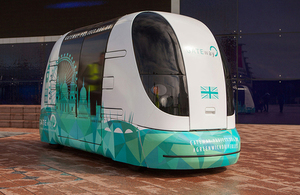Most of these reports, such as Wisconsin's, serve as AV primers for state legislators, government agencies, and others who work on transportation-related issues within a given state. They explain basic AV concepts, levels of automation, and how AVs differ from connected vehicles. Some explain well the traditional federal-state division of responsibilities over regulation and oversight of vehicle manufacturing, driver licensing, insurance, and infrastructure design. The Utah report does a nice job of describing the federal-state division of responsibilities, as well as which federal concerns are monitored by which federal agencies.
Progressive, inclusive, and geographically correct
These reports reflect the culture of each state, especially in terms of the scope of topics explored. Minnesota's report is a good example. This report emphasized equity and accessibility concerns, even describing the inclusiveness of the meetings that the Governor's advisory council in charge of the report conducted to discuss AV issues with people around the state.
The fear of an inequitable lack of balance between urban and rural areas was evident throughout the Minnesota report and, reflecting the concern with public perception, public engagement was a major priority for the advisory council.
Each meeting included remote participation. In addition to the public meetings, individuals could participate online, by survey, or share their feedback directly with the CAV-X office. To ensure transparency for the process, MnDOT placed all materials on its public website, including dates and times for each meeting. MnDOT conducted additional outreach activities for those unable to attend meetings, including individual meetings and calls, public events, presentations at various conferences and events, and a demonstration at the Minnesota State Fair. MnDOT also participated in intergovernmental consultation with tribal governments through the Advocacy Council on Tribal Transportation, the Minnesota Indian Affairs Council, and individual meetings with tribal executives. The final recommendations considered input from all of these outreach efforts.Unlike most such bodies, the Minnesota advisory council did not include any AV companies or car manufacturers. Instead the advisory council included staff from government, non-profit organizations, labor, the insurance industry, and the energy sector.
Transportation modes besides cars and trucks? What are those?
On the other end of the spectrum is the report from Idaho, which mostly ignores the possibility of shifting transportation modal choices, and explores the usual concerns of cybersecurity, privacy, licensing and insurance. This might be due to the fact that members of the Autonomous and Connected Vehicle Testing and Deployment Committee - that's a mouthful - were auto dealers, representatives of various vehicle associations, and lots of law enforcement staff. Transit was not represented.
Indeed, though none of the recommendations mention transit, walking, or biking, a subcommittee that included transit, biking, and walking advocates managed to include some interesting text in the report - just not in the executive summary or in the recommendations.
The predictable routes, limited number of vehicles, fixed infrastructure in the public right-of-way, and public oversight place public transit in a unique position to pilot AV/CV technology. By piloting AV/CV for transit, the public could become more familiar and comfortable with the technology. Enabling and deploying AV/CV technology for public transit would also provide operational benefits to transit agencies by providing more consistent operations at potentially lower costs.
... ... ...
In the future, most vehicles using Idaho’s transportation infrastructure may not be individually owned, as they are today. The Mobility as a Service (MaaS) model predicts that most vehicles would be owned by corporations or collectives, and dispatched to users on demand. This model already exists with services like UBER and Lyft that currently use human drivers. These services have pilot projects testing the use of AVs.
AV technology is accelerating faster in urban areas than rural areas. If state policies fail to address the needs of rural and local jurisdictions, the state could develop a disconnected network for AV/CV operations.Garden State: Not exactly innovative
 |
| Photo from Hyundai. https://www.motor1.com/news/300142/hyundai-elevate-concept-revealed/ |
*[In New Jersey, a joint resolution is defined as "a formal action adopted by both Houses (of the legislature) and approved by the Governor. A joint resolution has the effect of a law and is often used instead of a bill when the purpose is of a temporary nature, or to establish a commission or express an opinion."] As of Feb. 20, 2019, the Governor has not yet approved of this joint resolution.
While across the pond, if it's required for a 16 year old ...
 Meanwhile, Britain surges ahead in a much more organized fashion than we are seeing from the US federal government. The UK automotive minister and - love this title - future of mobility minister have announced that passing a stringent test, using the term "rigorous safety assessment," is required before an AV is permitted to be tested on UK roads.
Meanwhile, Britain surges ahead in a much more organized fashion than we are seeing from the US federal government. The UK automotive minister and - love this title - future of mobility minister have announced that passing a stringent test, using the term "rigorous safety assessment," is required before an AV is permitted to be tested on UK roads.The UK also has an AV report out of its Law Commission (jointly with the Scottish Law Commission) that provides a much more complete assessment of the legal issues surrounding AV laws and regulations. First, it examines the legal rules in other countries; second, it makes a distinction between partially automated vehicles (such as the Tesla autopilot system) and highly automated vehicles; third, it looks at local versus national control and whether new government agencies should be created or not. The report also raises the issue, in tort liability terms, of what a reasonable AV manufacturer or software updating company would do in terms of an obligation to update sensors, cameras, software, and other technology.
No comments:
Post a Comment